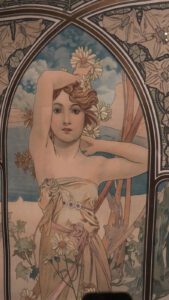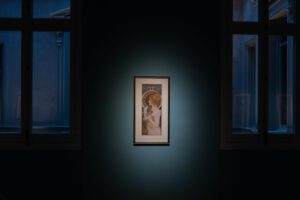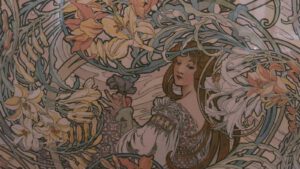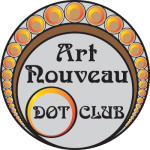Alfons Mucha exhibition at Palau Martorell, Barcelona, until October 15th
From July 5 to October 15, the exhibition dedicated to the Czech artist Alphonse Mucha (Ivančice, Czech Republic 1860 – Prague, Czech Republic, 1939), one of the greatest exponents of art nouveau, can be visited at the Palau Martorell in Barcelona. Alfons Mucha was a Czech painter and decorative artist who became one of the referents of Art Noveau. His posters, drawings and paintings are easily recognizable and are now on display at the Palau Martorell, in an exhibition with pieces from the Mucha Foundation, an institution that is in charge of preserving, conserving and promoting the artist’s legacy.
The exhibition is made up of more than 80 pieces, including his famous posters dedicated to “the divine” Sarah Bernhardt, commercial objects with his unmistakable designs, as well as photos and preparatory drawings of his works. It is the result of the most recent research that examines the theoretical aspect of Mucha’s work, especially the idea of beauty, the central principle of his art.
The exhibition, curated by the expert Tomoko Sato, is organized by the Palau Martorell in collaboration with the Mucha Foundation, and also analyzes how the artist expressed his Czech nationalism through his artistic language after his return to his native land in 1910. For this, the visitor will be able to enjoy the large-scale projection of the digital images of the 20 canvases that make up The Slavic Epic.
Alphonse Mucha was one of the most influential and famous artists of turn-of-the-century Paris, known above all for his graphic work: for the theater posters for the actress Sarah Bernhardt and for its decorative panels with elegant women with long hair.
Mucha created his own style characterized by harmonious compositions, sinuous shapes, organic lines and a muted palette, which became synonymous with the emerging new decorative style of the time: art nouveau.
However, despite the strong impact of Mucha’s style, the aesthetic ideas underlying its development are less well known. This exhibition wants to show the viewer the results of the most recent investigations that have been carried out around the idea of beauty, developed and conceptualized by Mucha, which undoubtedly was the central axis of all his work.
The exhibition, made up of more than 80 selected works from the Mucha Trust collection, features Mucha’s iconic posters and decorative works from his Parisian period. It also discusses how the artist expressed his Czech nationalism through his artistic language upon his return to his native Czechia.
The exhibition is divided into 3 thematic sections. The first is dedicated to women (the little carts of actress Sarah Bernhardt are included), the second focuses on the artist’s design formula (they are part, for example, of his well-known decorative panels) and the third shows works aimed at inspire the spiritual unity of the Slavic peoples, such as the oil painting Song of Bohemia, made in 1918, and the projection on large-scale digital images of the 20 canvases that make up ‘The Slav Epic’.
I. Muses
This section analyzes two groups of works: the theater posters for Sarah Bernhardt and the advertising posters for commercial products. By studying these works closely, Mucha’s design strategies will be explored, especially his use of images of beautiful women as icons and vehicles for commercial messages.
The exhibition welcomes us with Gismonda, the first poster designed by Mucha for Sarah Bernhardt. Portraying the best French actress of the day, Mucha transformed “The Divine Sarah” into a Byzantine goddess. This poster received immediate acclaim when it appeared on the billboards of Paris on New Year’s Day 1895. Its great visual impact lay in the use of an elongated format and subtle pastel colors, elegantly flowing contours to represent the sublime image of the actress, and the balance between simplicity and elaboration. It was undoubtedly surprising for the Paris of the time for its novelty.
Delighted with the success of this poster, Bernhardt offered Mucha a contract to design set and costume designs, as well as posters for her theatrical productions. Under this contract, which ran from 1895 to 1900, Mucha made six other posters for Bernhardt productions, including La Dame aux Camélias (1896), Lorenzaccio (1896) and La Samaritaine (1897), which can be seen at The exhibition.
Gismonda’s success also earned him numerous billboard commissions for famous brands such as JOB (cigarette paper), Lefèvre-Utile (biscuits) and Waverley.
This section also includes packaging design, such as boxes for cookies and perfumes; and the design of magazine covers such as Les Maîtres de l’Affiche.
II. New concept of art
In Mucha’s time, the concept of art underwent revolutionary changes with the advent of modernism. Consequently, the classical notion of ‘beauty’, one of the defining features of art, was also challenged and expanded to encompass new ideas.
In this time of change, Mucha pursued the universal and unchanging value of art. In this search, the artist came to believe that the ultimate goal of art was the expression of beauty, which would be achieved, in his opinion, through harmony between internal contents (ideas, messages) and external forms. . As he wrote in his notes, published posthumously in the book Lectures on Art (1975), Mucha believed that the role of the artist was to inspire people with this harmonious beauty and to raise the quality of their lives through the art of he.
To achieve this goal, Mucha developed a personal design formula, his own language to communicate, which used the image of a woman combined with flowers and other decorative motifs derived from Czech folk art, as well as from various exotic cultures.
For Mucha, the decorative panels, which can be seen in the exhibition, were an ideal medium for realizing his aspiration. First created by Mucha and his publisher, F. Champenois, they were mainly textless posters, designed for purely decorative purposes. Produced in large numbers, these panels were available to the general public, becoming an alternative form of art that could be displayed in ordinary homes.
In this sector of the exhibition there is an area dedicated to Mucha and photography. During the second half of the 1890s, photos began to play the role of a notebook and a visual diary for Mucha, which complemented his sketches and drawings.
Of note are the large number of images taken of models posing in his studio, many of which can be seen in the exhibition. Most of the time, instead of following a specific plan, sticking to specific projects, Mucha worked spontaneously with the models, improvising the most diverse poses. Many of these images served him later for a study, or as a source of inspiration for his designs and paintings.
III. The SLAV EPIC
Mucha returned to his homeland in 1910 to fulfill her dream of working for the political freedom of her country, culminating in his masterpiece The Slavic Epic (1912-1926) and other works intended to inspire the spiritual unity of the slavic peoples.
This section shows examples of the artist’s latest work, exploring how le style Mucha became the art of making messages.
Posters to inspire Czech-Slavic solidarity are on display here, as is his rare oil painting Song of Bohemia, made in 1918, the year his homeland gained independence.
The exhibition bids us farewell with a large-scale projection of digital images of the 20 canvases that make up The Slavic Epic, painted between 1912 and 1926, where Mucha presents the history of the Slavic people. The project was sponsored by a wealthy Chicago businessman and philanthropist, Charles Richard Crane (1858–1939), who, deeply interested in both Eastern European politics and Slavic culture, lent his financial and emotional support to the project. A lot over almost two decades.
In this series, Mucha represented the development of Slavic civilization from its origins in Antiquity, through the Middle Ages, the Reformation era and the consequences of the First World War, after which the Slavic countries gained independence from the Empire of the Habsburgs.
In 1928, Mucha donated the complete series of The Slavic Epic to the city of Prague as a gift to the country for the tenth anniversary of its independence.
The Nazis
When the Nazis entered Prague in 1939, one of their targets was Alfons Mucha (pronounced ‘Muja’) who was not only the country’s most respected and popular illustrator and artist but also a symbol of the nationalism of the young Czechoslav Republic of just 21 years of existence. The Nazis arrested the great 78-year-old Art Nouveau poster artist for a few days, an episode from which he would not recover, and that same year he would die. The family fled first from the Nazis and years later from communism. Today Marcus Mucha, the artist’s great-grandson, congratulates himself on that escape because otherwise he probably wouldn’t exist. He is the person in charge of the Mucha Foundation, which controls all of the artist’s works and who, together with the Japanese specialist, Tomoko Sato, has come to Barcelona to inaugurate the exhibition on Alfons Mucha at the recently renovated Palau Martorell.
The exhibition brings together 80 pieces, mostly color lithographs, some oils, eight photographs and an audiovisual, which perfectly reveal the author’s bourgeois and precious style, exemplified in those languid and iconic women, haloed with flowers that illustrated their commercial signs. Figures that adorned the Paris of the Belle Époque and made a strong comeback in the 1960s as decorative objects. Mucha, however, was much more: a patriot who opposed the Habsburg empire and a mystical philosopher and Freemason who aspired to the union of the Slavic peoples. “The ideas that underlie the author’s work are little known,” said Sato, who recalled that the years in which he worked in Paris and in which he established his fame were very important in coining an aesthetic based on psychoanalytic considerations. of Sigmund Freud, then so in vogue.



Useful information
Palau Martorell
Carrer Ample, 11. Barcelona
Hours: Monday to Sunday 10:00 a.m. – 8:00 p.m.
Entry: €14- General admission – €10- Reduced entry
Purchase tickets on the website www.palaumartorell.com and at the box office
